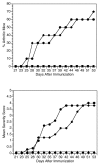Analog peptides of type II collagen can suppress arthritis in HLA-DR4 (DRB1*0401) transgenic mice
- PMID: 16982003
- PMCID: PMC1779432
- DOI: 10.1186/ar2043
Analog peptides of type II collagen can suppress arthritis in HLA-DR4 (DRB1*0401) transgenic mice
Abstract
Rheumatoid arthritis (RA) is an autoimmune disease associated with the recognition of self proteins secluded in diarthrodial joints. We have previously established that mice transgenic for the human DR genes associated with RA are susceptible to collagen-induced arthritis (CIA) and we have identified a determinant of type II collagen (CII(263-270)) that triggers T-cell immune responses in these mice. We have also determined that an analog of CII(263-270) would suppress disease in DR1 transgenic mice. Because the immunodominant determinant is the same for both DR1 transgenic and DR4 transgenic mice, we attempted to determine whether the analog peptide that was suppressive in DR1 transgenic mice would also be effective in suppressing CIA in DR4 transgenic mice. We treated DR4 transgenic mice with two analog peptides of CII that contained substitutions in the core of the immunodominant determinant: CII(256-276) (F263N, E266D) and CII(256-270) (F263N, E266A). Mice were observed for CIA, and T-cell proliferative responses were determined. Either peptide administered at the time of immunization with CII significantly downregulated arthritis. Binding studies demonstrated that replacement of the phenylalanine residue in position 263 of the CII peptide with asparagine significantly decreased the affinity of the peptide for the DR4 molecule. In contrast, replacement of the glutamic acid residue in position 266 with aspartic acid or with alanine had differing results. Aspartic acid reduced the affinity (35-fold) whereas alanine did not. Both peptides were capable of suppressing CIA. With the use of either peptide, CII(256-276) (F263N, E266D) or CII(256-270) (F263N, E266A), the modulation of CIA was associated with an increase in T-cell secretion of IL-4 together with a decrease in IFN-gamma. We have identified two analog peptides that are potent suppressors of CIA in DR4 transgenic mice. These experiments represent the first description of an analog peptide of CII recognized by T cells in the context of HLA-DR4 that can suppress autoimmune arthritis.
Figures



Similar articles
-
HLA-DR1 (DRB1*0101) and DR4 (DRB1*0401) use the same anchor residues for binding an immunodominant peptide derived from human type II collagen.J Immunol. 2002 Jan 1;168(1):253-9. doi: 10.4049/jimmunol.168.1.253. J Immunol. 2002. PMID: 11751969
-
Peptide-induced suppression of collagen-induced arthritis in HLA-DR1 transgenic mice.Arthritis Rheum. 2002 Dec;46(12):3369-77. doi: 10.1002/art.10687. Arthritis Rheum. 2002. PMID: 12483744
-
Collagen-induced arthritis mediated by HLA-DR1 (*0101) and HLA-DR4 (*0401).Am J Med Sci. 2004 Apr;327(4):169-79. doi: 10.1097/00000441-200404000-00002. Am J Med Sci. 2004. PMID: 15084912
-
Immunopathogenesis of collagen arthritis.Springer Semin Immunopathol. 2003 Aug;25(1):3-18. doi: 10.1007/s00281-003-0127-1. Springer Semin Immunopathol. 2003. PMID: 12904888 Review.
-
Transgenic mouse models of rheumatoid arthritis.Immunol Rev. 1999 Jun;169:161-73. doi: 10.1111/j.1600-065x.1999.tb01314.x. Immunol Rev. 1999. PMID: 10450516 Review.
Cited by
-
Antigen-specific tolerogenic and immunomodulatory strategies for the treatment of autoimmune arthritis.Semin Arthritis Rheum. 2008 Dec;38(3):195-207. doi: 10.1016/j.semarthrit.2007.10.002. Epub 2008 Jan 4. Semin Arthritis Rheum. 2008. PMID: 18177689 Free PMC article. Review.
-
Quantitative Prediction of the Landscape of T Cell Epitope Immunogenicity in Sequence Space.Front Immunol. 2019 Apr 16;10:827. doi: 10.3389/fimmu.2019.00827. eCollection 2019. Front Immunol. 2019. PMID: 31057550 Free PMC article.
-
Humanized Mouse Models of Rheumatoid Arthritis for Studies on Immunopathogenesis and Preclinical Testing of Cell-Based Therapies.Front Immunol. 2019 Feb 19;10:203. doi: 10.3389/fimmu.2019.00203. eCollection 2019. Front Immunol. 2019. PMID: 30837986 Free PMC article. Review.
-
Characterization of inhibitory T cells induced by an analog of type II collagen in an HLA-DR1 humanized mouse model of autoimmune arthritis.Arthritis Res Ther. 2012 May 8;14(3):R107. doi: 10.1186/ar3832. Arthritis Res Ther. 2012. PMID: 22569209 Free PMC article.
-
Chicken type II collagen induced immune balance of main subtype of helper T cells in mesenteric lymph node lymphocytes in rats with collagen-induced arthritis.Inflamm Res. 2010 May;59(5):369-77. doi: 10.1007/s00011-009-0109-4. Epub 2009 Oct 28. Inflamm Res. 2010. PMID: 19862478
References
-
- Nepom GT, Byers P, Seyfried C, Healey LA, Wilske KR, Stage D, Nepom BS. HLA genes associated with rheumatoid arthritis. Identification of susceptibility alleles using specific oligonucleotide probes. Arthritis Rheum. 1989;32:15–21. - PubMed
-
- Stastny P, Ball E, Kahn M, Olsen N, Pincus T, Gao X. HLA-DR4 and other genetic markers in rheumatoid arthritis. Br J Rheumatol. 1988;27:132–138. - PubMed
-
- Kim WU, Yoo WH, Park W, Kang YM, Kim SI, Park JH, Lee SS, Joo YS, Min JK, Hong YS, et al. IgG antibodies to type II collagen reflect inflammatory activity in patients with rheumatoid arthritis. J Rheumatol. 2000;27:575–581. - PubMed
Publication types
MeSH terms
Substances
Grants and funding
LinkOut - more resources
Full Text Sources
Other Literature Sources
Research Materials

